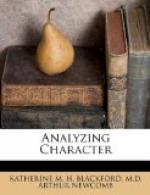But this book will find its way into the hands of many whose own vocational problems cry out for solution. Such need first to know themselves, to know their aptitudes and talents, whether developed or undeveloped. They need to study vocations—to know everything about the kinds of work they might do, from their requirements to their possibilities twenty, thirty, or forty years in the future. Finally, they need the courage, self-confidence, industry, progressiveness, and ambition to throw off the shackles of circumstance and, in the light of scientific truth, to press forward to the achievement, success, fulness of life, and happiness possible through development and use of all their powers.
CHAPTER II
ELEMENTS OF FITNESS
In our study are two small pieces of clear white marble. Each of them is decorated with a beautifully designed little flower in natural color. This flower is depicted by the skillful inlaying of semi-precious stones. These marbles came from Agra, India. They are samples of the handiwork which makes the Taj Mahal one of the most beautiful structures in the world. In the fitting of this inlay work the stones—some of them almost as hard as diamonds—are cut and polished to nearly mathematical accuracy of size and shape. But the more carefully and exactly these are made, the more badly they fit and the worse failure is the whole design, unless the spaces intended for them in the marble are likewise cut and prepared with nicety and accuracy. In the selecting of a life work, similarly, the same care must be taken in learning accurately the requirements of work—the exact size and shape, as it were, of each vocation—as is spent upon learning the exact qualifications of each individual. Both require common sense and intelligent judgment.
We measure a man’s height in centimeters or inches. Pounds and ounces or grams and centigrams offer us exact standards of measuring his weight. But there are no absolute standards for measuring the man himself, and probably there never can be. Human values, therefore, can be standardized only relatively. By the study of large groups we can, however, ascertain approximately the average or normal. In this way, physical standards have been set up as to pulse rate, temperature, respiration, etc. Chemical analysis determines norms of blood composition, and microscopic investigation determines the average number of blood corpuscles per cubic centimeter. The Binet-Simon mental tests are based upon certain approximate averages of intelligence and mental development established in the same way. The Muensterberg associated-word test of intelligence and other psychological experiments are among the efforts made to establish such standards. These are valuable as far as they go and probably yield all the information that their originators claim for them, which, unfortunately, is not a great deal. By time and motion studies, we are enabled to set up standards of efficiency that work out well in practice. All these, however, still leave us in the dark as to the man himself—his honesty, his loyalty, his highest and best values.




